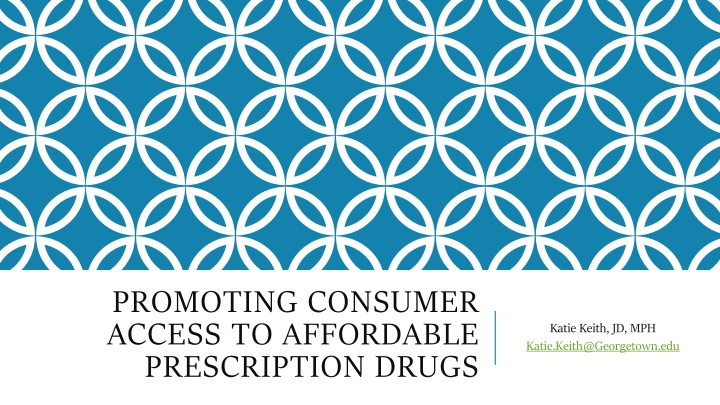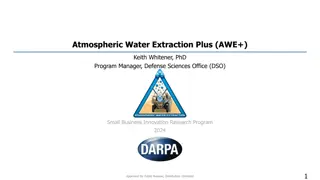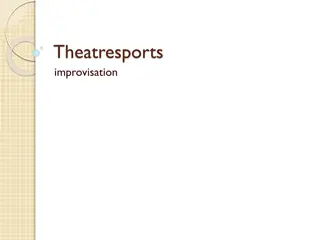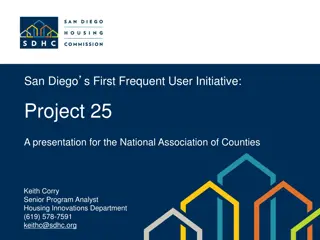
Promoting Access to Affordable Prescription Drugs: Strategies and Recommendations
Explore strategies and recommendations for promoting consumer access to affordable prescription drugs. Learn about key topics, reports, and initiatives aimed at improving access, affordability, transparency, and oversight in the prescription drug market. Discover insights on addressing emerging therapies and minimizing disparities in healthcare access.
Download Presentation

Please find below an Image/Link to download the presentation.
The content on the website is provided AS IS for your information and personal use only. It may not be sold, licensed, or shared on other websites without obtaining consent from the author. If you encounter any issues during the download, it is possible that the publisher has removed the file from their server.
You are allowed to download the files provided on this website for personal or commercial use, subject to the condition that they are used lawfully. All files are the property of their respective owners.
The content on the website is provided AS IS for your information and personal use only. It may not be sold, licensed, or shared on other websites without obtaining consent from the author.
E N D
Presentation Transcript
PROMOTING CONSUMER ACCESS TO AFFORDABLE PRESCRIPTION DRUGS Katie Keith, JD, MPH Katie.Keith@Georgetown.edu
SETTING THE STAGE Rate of Rx spending is increasing due to: Chronic conditions Scientific advancements Drug pricing Cost-shifting to consumers Affects utilization rates, esp. for underserved communities Can result in higher health care costs
REPORT: PROMOTING ACCESS TO AFFORDABLE PRESCRIPTION DRUGS Report on behalf of NAIC consumer representatives NAIC s Model Law 22 revision process Recommendations informed by: State approaches, QHP standards, Medicare Part D standards, consumer experience Disclaimer on drug pricing/costs Report: http://healthyfuturega.org/wp- content/uploads/2016/08/Promoting-Access-to- Affordable-Prescription-Drugs_Aug-2016.pdf
REPORT: PROMOTING ACCESS TO AFFORDABLE PRESCRIPTION DRUGS Topic areas Improving Access to Comprehensive Rx Coverage Consumer Affordability of Rx Coverage Nondiscrimination in Formulary Design Improving Transparency of Rx Coverage Meaningful Oversight and Regulation of Rx Benefits Addressing Emerging Therapies
IMPROVING ACCESS Pharmacy and therapeutics committees Have at least 15 members and adopt conflict of interest standards for P&T committees Exceptions and appeals processes Extend exceptions process to include cost-sharing/tiering and UM restrictions Pharmacy network access Adopt quantitative access standards for retail pharmacies, such as those used by Medicare Continuity of drug coverage Cover a one-time, temporary 30-day supply of a nonformulary drug for all enrollees Addressing health disparities Minimize cost-sharing or UM for drugs disproportionately used in underserved communities
ACCESS: STATE SPOTLIGHTS Betty can request a nonformulary drug that she d received for at least 6 months prior and receive a determination within 1 business day Betty can request an exception to her plan s fail first protocol and receive a determination within 3 business days
CONSUMER AFFORDABILITY Copays and coinsurance Prohibit coinsurance for Rx drugs (or require disclosure of actual dollar cost-sharing amount) Establish maximum levels of cost-sharing per Rx and/or per month Drug tiering Limit the total number of permitted drug tiers, define specialty tier, adopt standard plans Drug deductibles Disclose whether a plan uses a separate drug deductible and how it applies Value-based insurance design Adopt evidence-based incentives and allow for exceptions to VBID criteria
AFFORDABILITY: STATE SPOTLIGHTS Betty s cost-sharing for prescription drugs is capped: E.g., $150/specialty drug per 30-day supply E.g., $1,000/year for self-only coverage E.g., max cost-sharing of no more than 1/12 of the out-of-pocket max
NONDISCRIMINATION Comprehensive nondiscrimination protections Define discriminatory benefit design and prohibit specific examples in Rx context (i.e., placing most or all drugs for a specific condition on the highest cost-sharing tier) Solicit feedback from external stakeholders (advocates, CAPs, AG offices, ombudsmen, etc.) Adverse tiering Adopt standard plans with meaningful cost-sharing limits to mitigate adverse tiering Utilization management Adopt uniform standards for prior authorization requirements and responsiveness
NONDISCRIMINATION: STATE SPOTLIGHTS Prohibited plans from placing all drugs in a given class on a specialty tier OIR developed a chronic conditions template to track coverage of drugs used to treat certain conditions, such as breast cancer and bipolar disorder
IMPROVE TRANSPARENCY Access to comprehensive, accurate formularies Require standardized formulary display requirements so consumers can compare across plans, add more (accurate) information to formularies Limit mid-year formulary changes Prohibit mid-year formulary changes that negatively affect enrollee access to drugs (removing a formulary drug, moving a drug to a higher tier, or adopting new UM) Consumer support tools Require issuers to submit standardized Rx info in machine-readable formats and develop consumer-tested plan comparison tools based on consumer Rx needs
TRANSPARENCY: STATE SPOTLIGHTS Requires formularies to include cost-sharing amounts or ranges for each drug and UM requirements, among other information Prohibits many mid-year formulary changes such as removing a drug from a formulary, adding UM, or moving a drug to a higher cost- sharing tier
OVERSIGHT AND REGULATION Tools for monitoring and enforcement Collect standardized plan-level data on Rx drug benefits and analyze MCAS data Data collection and analysis Release more detailed information about Rx-related consumer complaints Regulation of pharmacy benefit managers Consider adopting policies related to licensure, information disclosure, accreditation, drug pricing, and fiduciary duties Collect data about PBM pricing, rebates, and conflicts of interest
OVERSIGHT: STATE SPOTLIGHTS CSI limited high coinsurance requirements for specialty tier drugs and required insurers to offer at least one plan at the silver level or above to have all copays OIR established an optional HIV/AIDS benefit design safe harbor with maximum cost-sharing in the form of fixed copays
ADDRESSING EMERGING THERAPIES Review new therapies within 90 days of FDA approval and make a coverage determination within 180 days of release onto market Ensure that routine patient costs are approved for clinical trial participants Encourage value-based pricing and other incentives for risk-sharing with drug manufacturers Participate in the development of value frameworks to assess the value of new treatments
QUESTIONS? Katie Keith, JD, MPH Katie.Keith@Georgetown.edu





















